Wild Medicinal Fungi and Their Survival Uses
Discover the hidden potential of wild medicinal fungi for survival situations. Learn how to identify, forage, and use these powerful natural remedies in the wilderness.
HERBALISM
Kathrine-Anne Hill
10/29/202414 min read
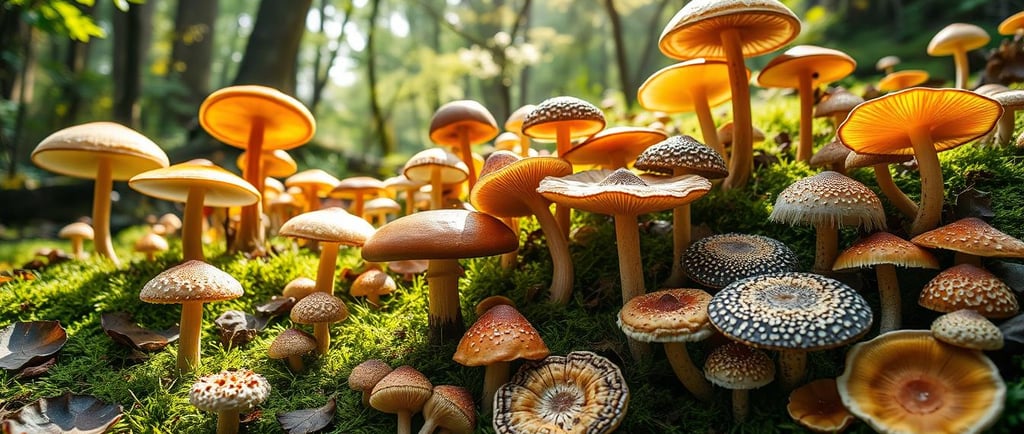

Affiliate Disclosure:
Please note that some of the links in this article are affiliate links. This means that if you click on these links and make a purchase, I may receive a small commission at no additional cost to you. This commission helps support the maintenance and growth of this website and allows me to continue providing valuable information and recommendations. Rest assured, I only recommend products and services that I have personally used or thoroughly researched. Your support is greatly appreciated! “As an Amazon Associate I earn from qualifying purchases.” For full disclosure see our Privacy Policy and Terms and Conditions here.
Wild Medicinal Fungi and Their Survival Uses
Have you ever thought about the forest floor hiding natural medicines? I've always been amazed by fungi and their health benefits. For thousands of years, wild medicinal fungi have helped us, with science just starting to learn about them.
Learning about wilderness survival, I see how important fungi are. They are full of powerful substances. These fungi can help us fight off sickness and boost our health.
Medicinal mushrooms have been around as long as humans. Ancient healers used them to cure diseases and improve health. Now, science is learning about their complex chemistry. Did you know one mushroom, Ganoderma lucidum, has over 200,000 compounds?
Exploring wild medicinal fungi, I'm amazed by their strength and ability to adapt. They are great helpers in survival situations. They can give us energy, support our immune system, and provide important nutrients.
Key Takeaways
Wild medicinal fungi have been used for thousands of years in traditional medicine.
Fungal foraging is a key wilderness survival skill.
Some mushroom species contain over 200,000 bioactive compounds.
Medicinal fungi can boost immunity and provide essential nutrients in survival situations.
Modern science is rediscovering the therapeutic value of wild fungi.
Introduction to Wild Medicinal Fungi
Wild medicinal fungi have been used for healing for centuries. They offer many health benefits, making them very useful. There are over 270 edible mushroom species and about 2000 safe ones.
Historical Use of Mushrooms in Medicine
Medicinal mushrooms have been used for thousands of years. In ancient Chile, people ate mushrooms 13,000 years ago. Chinese medicine has used fungi for a long time to prevent and treat diseases.
Today, research shows that mushrooms have around 130 health benefits.
The Relationship Between Fungi and Human Health
Fungi are closely related to animals, which helps explain their health benefits. They make compounds that boost our immune system. Mushrooms are very nutritious, with 20-30% protein and all essential amino acids.
Importance of Fungi in Ecosystems
Fungi are key to healthy ecosystems. They help form food webs and cycle nutrients. The biggest fungus on Earth is a honey mushroom mat in Oregon, over 2000 years old!
In survival situations, knowing about mycophagy can save lives. During the Bosnian War, mushrooms were a vital food source. People lost a lot of weight due to lack of food, but mushrooms helped them survive.
Understanding the Basics of Medicinal Mushrooms
I've found that medicinal mushrooms are a world full of natural health benefits. These fungi have been helping people for centuries. They are used in many cultures.
What are medicinal mushrooms?
Medicinal mushrooms are fungi that help our health. Out of 14,000 mushroom types, 270 are known for their health benefits. They are valued in Chinese culture for their healing powers.
Nutritional composition of mushrooms
Mushrooms are full of nutrients. They have a lot of protein and all the amino acids we need. They are also low in fat and have no cholesterol.
They are rich in vitamins B1, B2, B12, C, D, and E. They also have minerals like copper, phosphorus, and potassium.
Bioactive compounds in fungi
Mushrooms have special compounds that make them magical. These include polysaccharides, lectins, phenolic compounds, and terpenoids. β-glucan, for example, boosts our immune system.
These compounds help mushrooms fight off inflammation and germs. This makes mushrooms very good for our health.
Wild Medicinal Fungi and Their Survival Uses
Wild medicinal fungi are very useful for survival. They help with nutrition, boost immunity, and treat sicknesses. My studies show that 48 out of 79 North American mushrooms have new uses.
In survival situations, knowing about these fungi is key. Scientists have found 130 ways mushrooms can help us. They fight bacteria, reduce inflammation, and protect against damage.
There's a lot to discover in this area. Experts think there are 140,000 to 160,000 mushroom types worldwide. But only 10% have been studied. In North America, 22% to 55% of mushrooms are unknown for their healing powers.
These compounds are very effective, even in small amounts. Some work at just 10 μg/mL. Knowing how to use them can be a big advantage in survival situations.
Identifying Safe Wild Mushrooms
I've learned that knowing edible fungi is key for safe mushroom picking. In my journey, I've seen how important it is to tell safe mushrooms from dangerous ones.
Common Edible Mushroom Species
I've found many edible mushrooms on my adventures. Oyster mushrooms, shiitake, and maitake are easy to spot. They taste great and are good for you too.
Dangerous Look-alikes to Avoid
When picking mushrooms, be careful. Some poisonous mushrooms look like the good ones. For example, the deadly Amanita can look like safe ones. Knowing the difference is key for safe picking.
Tools and Resources for Mushroom Identification
I use many tools to identify mushrooms. Field guides are very helpful, with lots of pictures and details. I also join mycological societies for expert advice and trips.
Online groups, like Facebook, are great too. They have experts who help with mushroom pictures. Always check many sources and ask experts if you're unsure. It's safer to be careful with wild mushrooms.
Top Medicinal Mushrooms for Immune Support
Medicinal mushrooms are great for boosting our immune system. They've been used for ages in traditional medicine. Now, science confirms their benefits.
Eight mushrooms are known for their immune-boosting effects:
Chaga
Cordyceps
Lion's Mane
Maitake
Oyster
Reishi
Shiitake
Turkey Tail
Each mushroom has special compounds that help our immune system. For instance, β-glucans in many mushrooms help immune cells and act as prebiotics.
Studies show these mushrooms can strengthen both our innate and adaptive immunity. This means our bodies can fight off diseases better. Some mushrooms even help fight cancer.
In Japan, turkey tail mushrooms are used to help cancer patients. Research shows they can increase survival rates in those with gastric cancer. Reishi mushrooms also help lung cancer patients during chemo.
With over 14,000 mushroom species, we've just begun to explore their benefits. Adding these immune-boosting fungi to our diet could greatly improve our health.
Chaga: The Immune-Boosting Powerhouse
Chaga mushroom is amazing. It's a great helper for our immune system. This fungus grows on birch trees and is full of health benefits.
Harvesting and Preparing Chaga
Harvesting wild mushrooms needs skill and care. For chaga, I use methods that don't harm the environment. Here's how I get it ready:
Carefully remove outer layer
Break into small chunks
Dry thoroughly
Grind into powder
Steep in hot water for tea
Health Benefits and Traditional Uses
Chaga has been used for centuries. It's known for many health benefits. Here are some:
Precautions and Possible Side Effects
Chaga is usually safe, but not for everyone. I tell people to be careful, mainly if they have autoimmune diseases or take blood thinners. Always talk to a doctor before using chaga.
"Chaga mushroom is an antioxidant powerhouse, combating oxidative stress, inflammation, and lowering LDL cholesterol."
Chaga's strength comes from being natural. I choose organic, tested products. This ensures they're pure and help my immune system.
Reishi: The Mushroom of Immortality
Reishi mushroom is called the "king of mushrooms." It has been used for thousands of years. People call it the "mushroom of immortality" because of its health benefits.
In Traditional Chinese Medicine, reishi is in the highest class. It promotes longevity, wisdom, and happiness.
Reishi mushroom has many health benefits. It helps the heart by lowering blood pressure and cholesterol. It also boosts the immune system.
Reishi is good for many health issues. It protects the liver and helps with breathing problems. It also fights viruses like hepatitis B and herpes.
Reishi also helps with mental and emotional health. It calms insomnia and anxiety without making you sleepy. It's great for managing stress and improving sleep.
In survival situations, reishi is very useful. It supports the immune system and helps the body adapt. Its long history and scientific support make it a key part of natural medicine.
Lion's Mane: Neuroprotective and Cognitive Enhancer
Lion's mane mushroom, also known as Hericium erinaceus, is getting a lot of attention. It's not just tasty, but it might also help your brain work better.
Culinary Uses of Lion's Mane
Lion's mane mushroom is great in the kitchen. It tastes like meat and is perfect for veggie dishes. I like to cook it with garlic and herbs or grill it for a smoky taste. It makes many dishes healthier.
Scientific Research on Cognitive Benefits
Studies are showing that lion's mane might be good for your brain. It has special compounds that help grow brain cells. These might help improve memory and thinking skills.
Improves recognition memory in rodents
Stimulates nerve growth factor release
Reduces oxidative stress in nerve cells
Shows promise in treating cognitive disorders
Cultivation Techniques for Survival Situations
For those who love wilderness survival, growing lion's mane is useful. It grows on logs or sawdust, perfect for the outdoors. Having this mushroom in survival situations could be very helpful.
Lion's mane mushroom is special because it's tasty and might help your brain. Growing it in survival situations makes it even more interesting. It's great for food lovers and survival experts
Turkey Tail: Antiviral and Anticancer Properties
Turkey tail mushroom is a fascinating part of the medicinal mushrooms family. It has gained attention for its health benefits. This natural fungal medicine has impressive antiviral and anticancer properties.
Research shows turkey tail mushrooms have over 35 different phenolic compounds. These compounds contribute to their medicinal properties. Two powerful polysaccharopeptides, PSP and PSK, are known for their anticancer properties. Japan and China have used these compounds in cancer treatment.
A study on colorectal cancer patients found that turkey tail extract with chemotherapy improved survival rates. Also, 84.9% of women treated with a turkey tail-based vaginal gel for HPV infection showed normal pap smear results after six months.
While these findings are promising, more research is needed. If you're thinking of using turkey tail mushroom as a natural remedy, talk to a healthcare professional first. They can help make sure it's safe for you.
Cordyceps: Energy and Endurance Booster
Cordyceps is a fascinating fungus that boosts energy and endurance. It has a long history in traditional Chinese medicine. Now, it's also interesting to modern researchers and those who love wilderness survival.
Traditional Uses in Chinese Medicine
In Chinese medicine, cordyceps has been used for centuries. It boosts vitality and treats many ailments. A study by Che YS and Lin LZ found it helps with heart disease and high cholesterol.
Modern Research on Athletic Performance
Recent studies show cordyceps can improve athletic performance. Chen et al. did a trial on older subjects. They found cordyceps helped them exercise better.
Ethical Considerations in Harvesting
While cordyceps is promising, we must harvest it ethically. The natural Cordyceps sinensis yield has dropped by over 90%. This makes it very expensive. We need to grow it sustainably to save this valuable mushroom.
As we look into cordyceps for energy and survival, we must also think about saving it. We need to make sure it's here for future generations.
Foraging Techniques for Wild Medicinal Fungi
Fungal foraging is a key wilderness survival skill. It needs careful detail and respect for nature. Sustainable practices help keep these resources safe.
When I go foraging, I stick to the 5% rule. This means I only take 5% from any patch. I also limit my collection to 25% of an area. This lets the fungi grow and thrive.
A reliable field guide
A sharp knife
A breathable basket
A magnifying glass
I highly recommend the VylerSky Foraging Kit from Amazon, which comes with a mesh bag and a foraging knife with a brush. A couple different reliable field guides are Samuel Thayer's "The Forager's Harvest" and "Edible Wild Plants" by John Kallas.
Identifying mushrooms right is very important. Talking to experts or Indigenous people can teach a lot. They know about medicinal uses and look-alikes. Also, 90% of mushroom poisonings in North America are from Amanita species.
Learning survival skills has given me food and medicine. It also helps keep nature balanced. Always check the rules before foraging and leave nothing behind.
Preservation Methods for Wild Mushrooms
When I harvest wild mushrooms, keeping them fresh is key. I've learned a few ways to keep them good for a long time. This is important for survival in the wild.
Drying and Dehydration Techniques
Drying is my favorite way to keep mushrooms fresh. I use a food dehydrator, but you can also use your oven or the sun. Make sure to slice them thin so they dry evenly.
This method keeps the nutrients in and makes them last longer.
Tincture and Extract Preparation
To make tinctures, I soak mushrooms in alcohol for weeks. This pulls out the good stuff, making a strong medicine. If you don't want alcohol, you can use glycerin instead.
Long-term Storage Solutions
For keeping mushrooms for a really long time, I vacuum-seal them or put them in airtight containers. It's important to label them well. I write down the type, when I picked them, and what they're for.
Learning these ways to preserve mushrooms has helped me a lot. It's made my survival skills better and given me a steady supply of medicine.
Legal and Ethical Considerations in Mushroom Foraging
I've seen a big rise in mushroom hunting. In summer 2020, urban foraging on social media tripled. Sites like Instagram and TikTok are full of tips on finding wild mushrooms. But, we must be careful.
It's key to know the laws of foraging. Many places need permits or have rules on how much you can pick. I always check the rules before I go. It's important to respect private land and not go where you shouldn't.
Ethical foraging means we must be kind to nature. Linda Black Elk, a Catawba Nation educator, teaches us to be balanced and give back to nature. This means picking only what we need and not damaging the forest.
Here are some key ethical foraging practices:
Leave the forest cleaner than you found it
Avoid foraging in large groups
Know the best harvesting methods for each species
Be prepared with proper gear
In survival situations, we might feel we need to take a lot. But, we must think about the future. Sustainable mushroom hunting lets future generations enjoy these amazing plants too.
"We are not separate from nature, we are nature. Our role is to live in harmony with the natural world, not to dominate it."
October is a great time to find medicinal mushrooms. But, always choose ethical ways over personal gain. This way, we keep these valuable resources safe for the future.
Incorporating Medicinal Mushrooms into Your Survival Kit
Adding medicinal mushrooms to my survival kit has changed the game. There are over 2,000 edible or medicinal fungi to choose from. They are a compact and lightweight way to support health in emergencies.
I always carry dried mushrooms, powders, and tinctures of chaga, reishi, and turkey tail. These mushrooms boost the immune system. I also carry a small guidebook for identification and use.
Here's a quick list of what I include in my mushroom-based survival kit:
Dried chaga chunks for immune support
Reishi powder for stress management
Turkey tail tincture for antiviral properties
Puffball powder as a natural hemostatic agent
Compact field guide for mushroom identification
Basic tools for harvesting and processing wild mushrooms
By adding these medicinal mushrooms to my kit, I'm ready to use nature's pharmacy. Studies show mushrooms have about 100 medical uses. I'm confident they can help in survival situations.
"Mushrooms are not just food, they're medicine. In a survival situation, knowing how to use them could be the difference between life and death." - Expert Mycologist
When foraging for wild mushrooms, always be safe and know what you're picking. With the right knowledge, medicinal mushrooms are a great addition to any survival plan.
Conclusion
Wild medicinal fungi are amazing for survival and health. They've helped humans for centuries. These mushrooms support our immune system and even our brains.
There are over 700 types of wild medicinal fungi. They have special compounds that help us. Edible mushrooms are also full of nutrients like protein and minerals.
Medicinal mushrooms can do a lot for us. They help with wounds, stress, diabetes, and heart problems. But we must identify them right and harvest them carefully. This way, we can keep using them for years to come.
For further reading, refer to my article on Medium.com, "Foraging for Wild Edibles"
FAQ
What are medicinal mushrooms?
Medicinal mushrooms are fungi that are good for your health. They have special compounds that help your body. These compounds are found in mushrooms like oyster, shiitake, and maitake.
What are some common edible mushroom species?
Common edible mushrooms include oyster, shiitake, and maitake. But, be careful of mushrooms that look similar but are poisonous.
How can I identify safe wild mushrooms?
Use field guides and join mycological societies to learn about mushrooms. Go on tours with experts to make sure you pick the right ones.
What are some top medicinal mushrooms for immune support?
Mushrooms like chaga, cordyceps, and reishi boost your immune system. They also include oyster, shiitake, and turkey tail mushrooms.
What are the benefits and uses of chaga mushroom?
Chaga mushrooms boost your immune system and fight off free radicals. They have compounds that might fight cancer. You can drink chaga tea or take it as a tincture.
What makes reishi mushroom unique?
Reishi mushrooms are known for their health benefits. They help your immune system and may fight inflammation. They could also help your gut health.
Why is Lion's Mane mushroom beneficial for cognitive function?
Lion's Mane mushrooms might protect your brain and improve thinking. They could also help your gut and nerves.
What are the medicinal properties of Turkey Tail mushroom?
Turkey Tail mushrooms fight fungal infections and cancer. They might also help with AIDS. They have been shown to fight breast cancer.
How can I properly forage for wild medicinal fungi?
Learn to identify mushrooms and harvest them sustainably. Use tools like field guides and knives. Know where and when to find different mushrooms.
How can I preserve wild mushrooms for long-term use?
Dry mushrooms or make tinctures to keep them fresh. Store them in airtight containers or vacuum-seal them. This keeps their health benefits.
What legal and ethical considerations should I be aware of when foraging for mushrooms?
Learn the laws about picking mushrooms. Always respect private land and protected areas. Make sure your foraging doesn't harm the environment.
How can I incorporate medicinal mushrooms into my survival kit?
Add dried mushrooms, powders, or tinctures to your kit. Include tools for picking and processing. This keeps you healthy in tough times.
Related Posts:

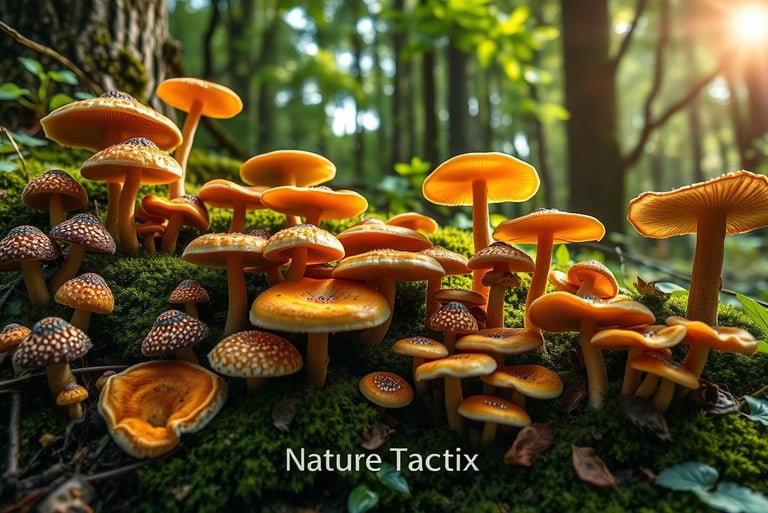

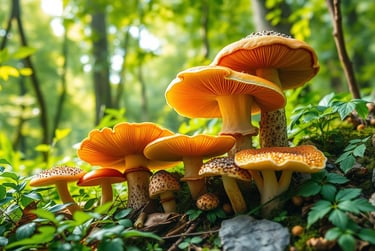

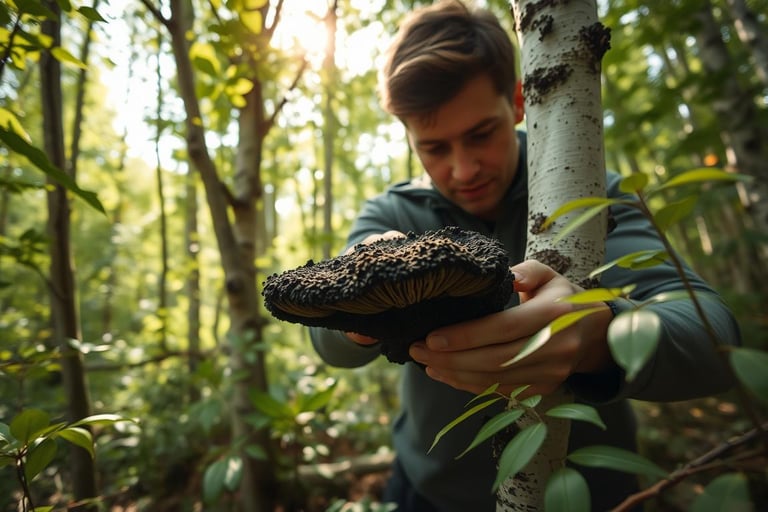

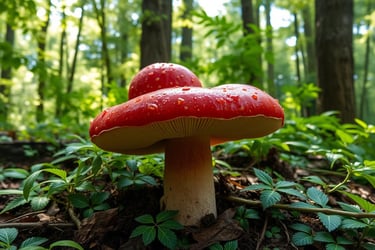


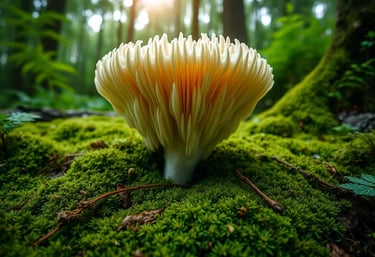
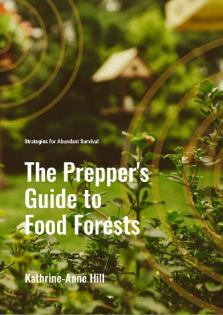

The Prepper's Guide to Food Forests: Strategies for Abundant Survival is a concise, step-by-step guide to creating a self-sustaining food forest. Ideal for preppers, it covers essential topics like design, plant selection, permaculture, companion planting, and wildlife integration. Learn how to maintain your forest, boost yields, and make it part of your survival strategy.
Highlights:
Basics of food forests and their benefits
Designing and selecting resilient plants
Creating a self-sustaining ecosystem
Using permaculture and companion planting
Maintenance, harvesting, and wildlife habitats
Food forests as part of a prepper strategy
Perfect for anyone seeking long-term food security.
Sign-Up and receive my FREE eBook The Prepper's Guide to Food Forests: Strategies for Abundant Survival !
As always, be sure to check our website for more wilderness tips and gear updates!
